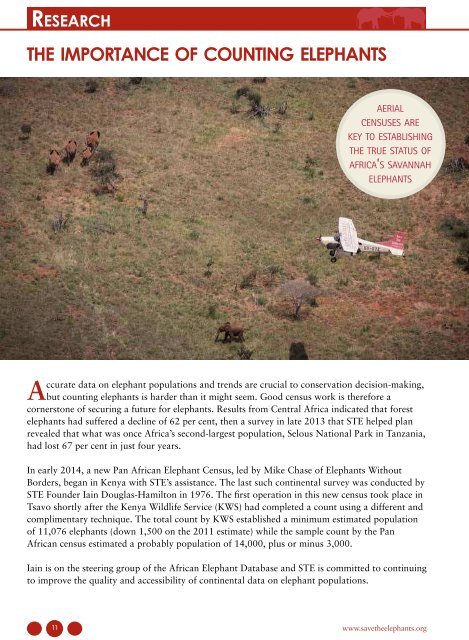2014_STEAnnualReport
2014_STEAnnualReport
2014_STEAnnualReport
Create successful ePaper yourself
Turn your PDF publications into a flip-book with our unique Google optimized e-Paper software.
Researchthe importance of counting elephantsaerialcensuses arekey to establishingthe true status ofafrica’s savannahelephantsmonitoring the illegal killing of elephantssIn the midst of the ivory poaching crisis, sensitiveindicators of poaching pressure are critical foridentifying the populations across the continent thatare most at risk.Over 100,000 elephants were killed fortheir ivory between 2010 and 2012 accordingto new research led by George Wittemyer,chairman of STE’s Scientific AdvisoryBoard. The broad coalition of researchers heassembled drew on data and experience fromintensively monitored sites across Africa,including Samburu.Speculation about the number of elephantsbeing lost has been rampant, but this studyprovides an important, peer-reviewed estimate ofthe impacts of the ongoing ivory crisis on Africa’selephant populations. The number of elephants remainingin Africa is uncertain, but the losses drove declines in theworld’s wild African elephants in the order of 2-3% a year during those three years. Preliminarydata indicates unsustainable poaching continued during 2013.Accurate data on elephant populations and trends are crucial to conservation decision-making,but counting elephants is harder than it might seem. Good census work is therefore acornerstone of securing a future for elephants. Results from Central Africa indicated that forestelephants had suffered a decline of 62 per cent, then a survey in late 2013 that STE helped planrevealed that what was once Africa’s second-largest population, Selous National Park in Tanzania,had lost 67 per cent in just four years.In early <strong>2014</strong>, a new Pan African Elephant Census, led by Mike Chase of Elephants WithoutBorders, began in Kenya with STE’s assistance. The last such continental survey was conducted bySTE Founder Iain Douglas-Hamilton in 1976. The first operation in this new census took place inTsavo shortly after the Kenya Wildlife Service (KWS) had completed a count using a different andcomplimentary technique. The total count by KWS established a minimum estimated populationof 11,076 elephants (down 1,500 on the 2011 estimate) while the sample count by the PanAfrican census estimated a probably population of 14,000, plus or minus 3,000.Iain is on the steering group of the African Elephant Database and STE is committed to continuingto improve the quality and accessibility of continental data on elephant populations.The Monitoring of Illegal Killing of Elephants (MIKE) programme has served as the most sensitivebarometer of poaching pressure since 2001, receiving data from 42 sample sites Africa-wide.Data from the Samburu-Laikipia MIKE site in Northern Kenya shows that illegal killing peakedin 2012. That year 73 per cent of carcasses found had been illegally killed, while by 2013 theProportion of Illegally Killed Elephants (PIKE) had fallen for the first time since the ivory crisisbegan in 2008, reducing to 62 per cent (see graph).Although thesituation appearsto be improvingin Samburu, thetotal elephantpopulations ofboth East andCentral Africa arenow registeringdeclines alongwith manypopulations in theSouth.11 www.savetheelephants.orgSECURING A FUTURE FOR ELEPHANTS12


